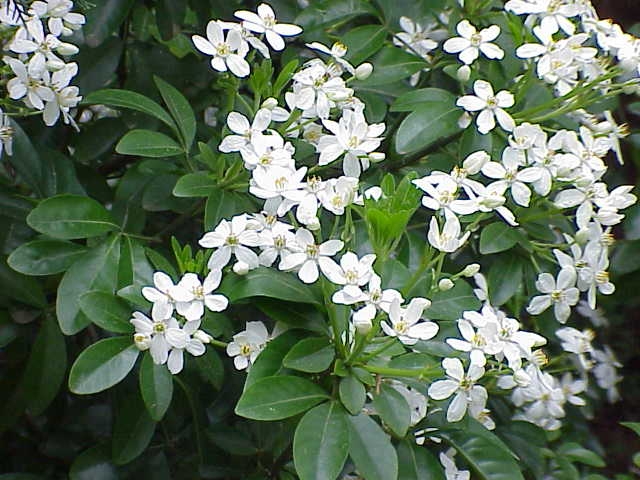Mexican Orange
(Choisya ternata)
Mexican Orange (Choisya ternata)
/
/

Kurt Stüber [1]
CC BY-SA 3.0
Image By:
Kurt Stüber [1]
Recorded By:
Copyright:
CC BY-SA 3.0
Copyright Notice:
Photo by: Kurt Stüber [1] | License Type: CC BY-SA 3.0 | License URL: http://creativecommons.org/licenses/by-sa/3.0/ | Uploader: Topjabot | Publisher: Wikimedia Commons | Title: Choisya_ternata_2004-2.jpg | Notes: Uploaded own work with UploadWizard |
































































Estimated Native Range
Summary
Choisya ternata, commonly known as Mexican Orange, is an evergreen shrub native to Mexico, particularly found in the high elevations of the Sierra Madre Occidental. It typically grows to a height of up to 3 meters (10 feet) and spreads similarly, forming a dense, rounded shape. The leaves are bright green, glossy, and palmately compound with three leaflets, hence the species epithet ’ternata.’ They emit a pleasant fragrance reminiscent of basil when crushed. From late spring to early summer, and occasionally in the autumn, Choisya ternata produces clusters of star-shaped, white flowers that are highly fragrant and attract pollinators.
This shrub is valued for its aromatic foliage, showy flowers, and general hardiness. It is often used in urban landscapes, as a border plant, or as an informal hedge. It is also suitable for container planting due to its manageable size. While drought-tolerant once established, Choisya ternata performs best with regular watering and well-drained soil. It prefers full sun to part shade and can tolerate a range of soil types, though it thrives in fertile, loamy soils. Pruning after flowering helps maintain its shape and promotes denser growth. It is hardy to USDA Zone 7, tolerating temperatures down to −10 °C (14 °F), but can be damaged by temperatures below −15 °C (5 °F). Potential problems include infestations by aphids and damage from snails and slugs.CC BY-SA 4.0
This shrub is valued for its aromatic foliage, showy flowers, and general hardiness. It is often used in urban landscapes, as a border plant, or as an informal hedge. It is also suitable for container planting due to its manageable size. While drought-tolerant once established, Choisya ternata performs best with regular watering and well-drained soil. It prefers full sun to part shade and can tolerate a range of soil types, though it thrives in fertile, loamy soils. Pruning after flowering helps maintain its shape and promotes denser growth. It is hardy to USDA Zone 7, tolerating temperatures down to −10 °C (14 °F), but can be damaged by temperatures below −15 °C (5 °F). Potential problems include infestations by aphids and damage from snails and slugs.CC BY-SA 4.0
Plant Description
- Plant Type: Shrub
- Height: 4-8 feet
- Width: 4-8 feet
- Growth Rate: Moderate
- Flower Color: White
- Flowering Season: Spring, Summer, Fall
- Leaf Retention: Evergreen
Growth Requirements
- Sun: Full Sun, Part Shade
- Water: Medium
- Drainage: Medium, Slow
Common Uses
Bird Garden, Border Plant, Butterfly Garden, Deer Resistant, Drought Tolerant, Fragrant, Hedges, Low Maintenance, Potted Plant, Rabbit Resistant, Salt Tolerant, Showy Flowers, Street Planting
Natural Habitat
High elevations of the Sierra Madre Occidental
Other Names
Common Names: Mexican-Orange , Mexican-Orange Blossom , Mexikanische Orangenblume , Sanktpatriksbuske
Scientific Names: Choisya ternata , Choisya grandiflora , Juliania caryophillata
GBIF Accepted Name: Choisya ternata Kunth